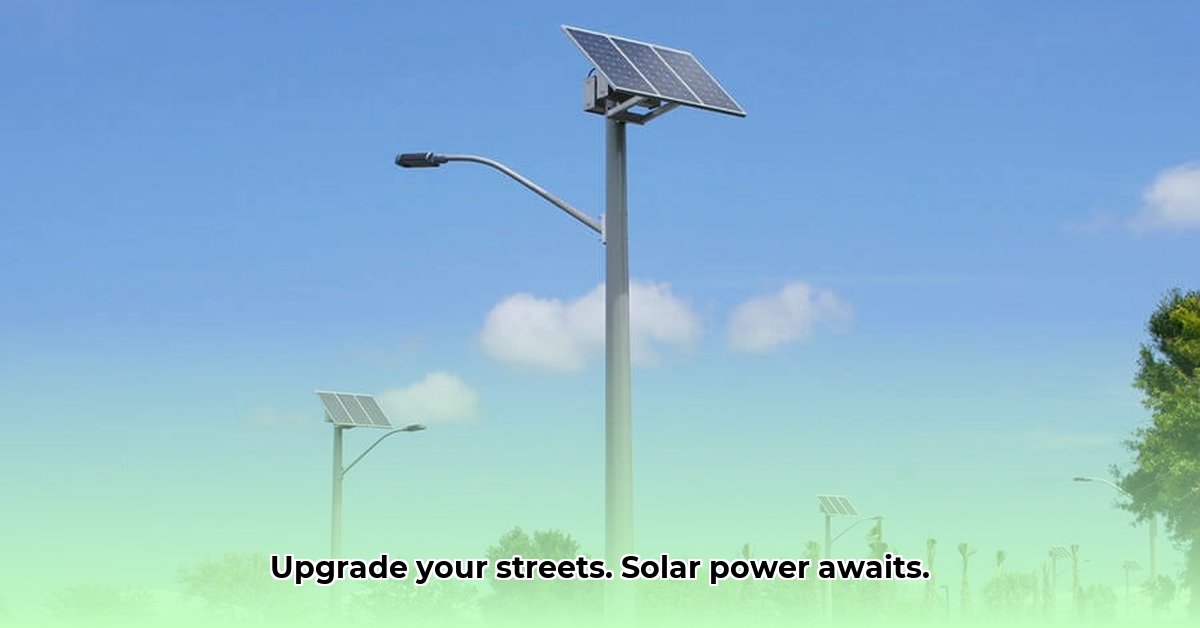Thinking about swapping out those old, energy-guzzling streetlights? Solar power is becoming a really popular, and smart, way to light up our streets and properties. This guide is your shortcut to understanding everything about solar streetlights – from how they work and which ones are best for you, to getting them installed and keeping them shining bright for years. We’ll cut through the tech jargon and show you exactly what to look for, whether you’re a homeowner brightening your driveway or a city planner lighting up a whole neighborhood. We’ll even share some insider tips and real-world examples to make your decision easier and more confident.
Solar Energy Street Lights: Shining a Light on Your Choices
Considering replacing traditional streetlights with solar-powered alternatives is growing in popularity, especially given the energy saving opportunities. Solar energy street lights are becoming increasingly popular, thanks to their eco-friendly nature and money-saving potential. Let’s dive into what makes them tick and how to pick the perfect ones based on your project needs.
Understanding the Technology: More Than Just Illumination
Solar street lights aren’t your grandpa’s streetlights; they’re cleverly designed lighting systems, combining several key parts to work together. Think of it like a well-organized team: each player has a vital role.
First, you have the solar panels – these are the energy collectors, soaking up the sun’s power. Then, there’s the battery, acting as a storage tank, holding onto the energy collected throughout the day for use at night. The LEDs are the actual lights – they’re super efficient, using less energy to produce bright light illumination. Many modern lights also include “smart” features such as motion sensors (only turn the light on when needed, saving even more energy), or remote control capabilities (for easier management), which maximizes energy efficiency.
How well these parts work together determines the light’s performance. Look for specs like lumen output (how bright the light is), battery capacity (mAh – milliampere-hour, indicating how long the battery lasts), charging time, and how many hours the light will stay on after a full charge. Also, pay close attention to the IP rating (Ingress Protection). This rating shows how well the light is protected from water and dust – a higher IP rating means it’s better suited for tough outdoor conditions. Factors influencing efficiency include panel size, battery type, and LED efficiency.
Choosing Your Perfect Solar Street Lights: Finding the Right Fit
Selecting the right solar street light is a bit like choosing the right pair of shoes – you need to consider several factors to ensure a comfortable and effective fit.
First, consider your location. How much sunlight does your area get? A sunny spot means more energy, while a shady area might require a light with a larger battery. Your budget is another key player – prices vary widely depending on features and quality. How bright do you need the light to be (lumens)? Do you need a powerful light for a wide area, or will a smaller, energy-efficient model suffice? Smart features like motion sensors can be handy, but they usually add to the cost. Finally, always check the warranty – a good warranty demonstrates the manufacturer’s confidence in their product’s durability, ensuring protection for your investment.
Here’s a handy table summarizing key considerations:
| Feature | Considerations |
|---|---|
| Lumen Output | Higher lumens = brighter light, but higher energy consumption. Match brightness to the area. |
| Battery Capacity (mAh) | Larger capacity = longer operation time. Crucial for areas with less sunlight or longer nights. |
| Charging Time | Faster charging is great, especially in areas with unpredictable sunlight. |
| IP Rating | Higher IP ratings (e.g., IP65, IP67) offer superior protection against the elements. Essential! |
| Smart Features | Motion sensors save energy, remote control adds convenience. Weigh the cost and benefits. |
| Warranty | A solid warranty shows the manufacturer believes in their product’s longevity. |
Selecting Outdoor Solar Lights: Installation and Maintenance
Installing solar street lights might seem easy, but proper placement is crucial for optimal performance. Aim for locations that receive maximum sunlight throughout the day. Depending on the scale of your project (a single light for your yard versus lighting a whole neighborhood), professional installation might be necessary.
Maintenance is generally low-key. Regularly cleaning the solar panels will keep them working efficiently. Eventually, you’ll probably need to replace the batteries – their lifespan is limited. Consider the cost of replacements during your decision-making process. Expect to replace batteries every 5-7 years, depending on the battery type and usage.
Market Trends and the Future: Sustainable Energy Solutions
The solar street light market is experiencing rapid growth. People are increasingly aware of the environmental benefits, and the technology is continuously improving, making these lights more affordable and efficient. We’re seeing advancements in battery technology, more efficient LEDs, and exciting innovations in smart control systems.
However, some challenges remain, such as global supply chain issues that can occasionally affect pricing and availability, and the need for better standardization across the industry. Despite these hurdles, the future looks bright for solar street lights, particularly as cities embrace smart technology and sustainable energy solutions. Government incentives, like tax credits and rebates, are also driving adoption.
Case Study: Real-World Success
One small town in California successfully replaced its traditional streetlights with solar-powered alternatives. They witnessed a substantial decrease in their electricity bills and a notable improvement in public safety, demonstrating the practical advantages of making the switch. Specifically, the town saw a 60% reduction in energy costs and a 20% decrease in reported crime in poorly lit areas.
Choosing the right solar street lights is a decision with far-reaching implications. Using this guide, you can confidently navigate the available options and illuminate the path towards a brighter, more sustainable future. Remember to always check reviews and compare prices before you buy! Consumers look for reviews that specifically mention battery life, brightness consistency, and weather resistance.
How to choose the best solar street lights based on lumen output and battery life
Key Takeaways:
- Solar street lights offer significant energy savings (60-80% reduction).
- Choosing the right lumen output is crucial for effective illumination.
- High-efficiency LEDs and lithium-ion batteries are recommended.
- Battery lifespan varies (5-8 years or 1500-2000 charge cycles).
- Consider location-specific factors (sunlight, weather).
- Weigh initial investment against long-term savings.
- Regulatory compliance is vital.
Understanding Solar Street Light Technology: Efficient Use of Solar Energy
Let’s dive into the components of these eco-friendly luminaries. Solar panels convert sunlight into electricity, charging the battery. These batteries, typically lithium-ion for longer life, power the LEDs at night. Smart features, like motion sensors or dimming capabilities, add efficiency and security. Remember the IP rating – this indicates how well the light withstands dust and water. Higher is better! Solar energy reduces reliance on fossil fuels and minimizes carbon footprint.
How to choose the best solar street lights based on lumen output and battery life: Strategic Considerations
Lumen output dictates brightness; More lumens mean brighter illumination. Lumens influence the brightness, where more lumens correlate to brighter illumination. How many lumens do you need? It depends on the area you’re lighting – a large field needs more than a small walkway. Consider your budget too; higher lumen output usually means a higher price tag. Battery life is just as important. Longer battery life translates to less maintenance and fewer replacements. This is where lithium-ion batteries shine, since they also recharge faster than older technologies.
Imagine choosing paint for your house – you wouldn’t pick a dark color for a dimly lit room, right? Similarly, you need the right lumens for your space.
Here’s a simplified guide:
| Area | Recommended Lumens (approx.) |
|---|---|
| Small Pathway | 500-1000 |
| Driveway | 1000-2000 |
| Large Field | 2000+ |
Installation and Maintenance: Best Practices
Installation is straightforward for many models, but hiring a professional is always an option. Regular maintenance involves cleaning solar panels and checking battery health. This ensures optimal performance for years to come. Think of it like car maintenance – a little upkeep goes a long way!
Market Trends and Challenges: Overcoming Obstacles in Street Lighting
The solar street light market is booming. Technological advancements are constantly improving efficiency and cost-effectiveness. However, challenges remain, and ensuring consistent performance in varied weather and addressing light pollution concerns exist. Manufacturers rigorously test solar street lights for weather resistance, battery performance under various temperatures, and light output consistency.
Case Study: Success Stories
In a rural farming community in Oregon, the implementation of solar street lights along farm access roads resulted in a 40% decrease in nighttime accidents involving farm equipment and vehicles. The improved visibility also deterred theft and vandalism, enhancing security for local farmers.
Solar Street Lights for Residential Areas: A Comprehensive Guide
Key Takeaways:
- Solar street lights offer long-term cost savings and environmental benefits compared to traditional lighting.
- Careful site selection is crucial for optimal performance, considering sunlight availability and local climate.
- Different battery technologies (lead-acid vs. lithium-ion) present trade-offs in cost, lifespan, and environmental impact.
- Regular maintenance, including panel cleaning, is essential for sustained performance.
- Compliance with local electrical codes and safety regulations is
- Wind Turbine Fire: Questions About Safety Spark Debate - October 31, 2025
- Vertical Axis Wind Turbine Design: Improving Efficiency and Overcoming Limits - October 29, 2025
- Wind Turbine to Power Home: Nacelle Design Improvements Advance - October 26, 2025
















